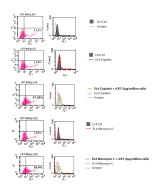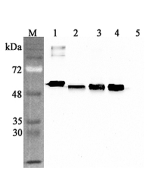Cookie Policy: This site uses cookies to improve your experience. You can find out more about our use of cookies in our Privacy Policy. By continuing to browse this site you agree to our use of cookies.
AdipoGen Life Sciences
anti-Calreticulin (human), mAb (CR213-2AG)

1: Human Calreticulin (His-tagged).
2: HEK 293T cell lysates (100μg).
3: HepG2 cell lysates (100μg).
4: THP1 cell lysates (100μg).
5: Human FTO (His-tagged) (negative control).
| Product Details | |
|---|---|
| Synonyms | CRP55; Calregulin; Endoplasmic Reticulum Resident Protein 60; ERp60; grp60 |
| Product Type | Monoclonal Antibody |
| Properties | |
| Clone | CR213-2AG |
| Isotype | Mouse IgG1κ |
| Immunogen/Antigen | Recombinant human calreticulin. |
| Application |
ELISA: (direct and indirect: 1:2’000-1:5’000) |
| Crossreactivity | Human |
| Specificity |
Recognizes human calreticulin. |
| Purity Detail | Protein G-affinity purified. |
| Concentration | 1mg/ml |
| Formulation | Liquid. 0.2μm-filtered solution in PBS, pH 7.4. Contains no preservatives. |
| Isotype Negative Control | |
| Shipping and Handling | |
| Shipping | BLUE ICE |
| Short Term Storage | +4°C |
| Long Term Storage | -20°C |
| Handling Advice |
After opening, prepare aliquots and store at -20°C. Avoid freeze/thaw cycles. |
| Use/Stability | Stable for at least 1 year after receipt when stored at -20°C. |
| Documents | |
| MSDS |
 Download PDF Download PDF |
| Product Specification Sheet | |
| Datasheet |
 Download PDF Download PDF |
Calreticulin is involved in regulation of intracellular Ca2+ homoeostasis and ER Ca2+ capacity. It constitutes together with calnexin and ERp57 the 'calreticulin/calnexin cycle' that is responsible for folding and quality control of newly synthesized glycoproteins. Calreticulin has been implicated to play a role in many biological systems, including functions inside and outside the ER, indicating that the protein is a multi-process molecule. Recently, calreticulin has been identified as an endogenous ligand of the NK cell receptor NKp46. NKp46 recognizes externalized calreticulin (ecto-CRT), which translocates from the endoplasmic reticulum (ER) to the cell membrane during ER stress. ER stress and ecto-CRT are hallmarks of chemotherapy-induced immunogenic cell death, favivirus infection and senescence. NKp46-mediated killing is inhibited by knockout or knockdown of CALR, the gene encoding CRT, or CRT antibodies, and is enhanced by ectopic expression of glycosylphosphatidylinositol-anchored CRT. NKp46 recognition of ecto-CRT as a danger-associated molecular pattern eliminates ER-stressed cells.







